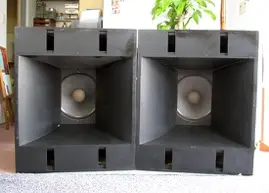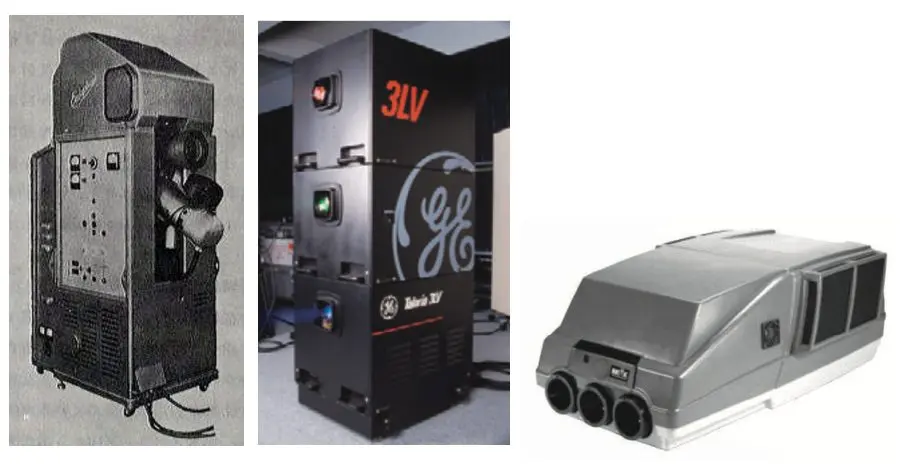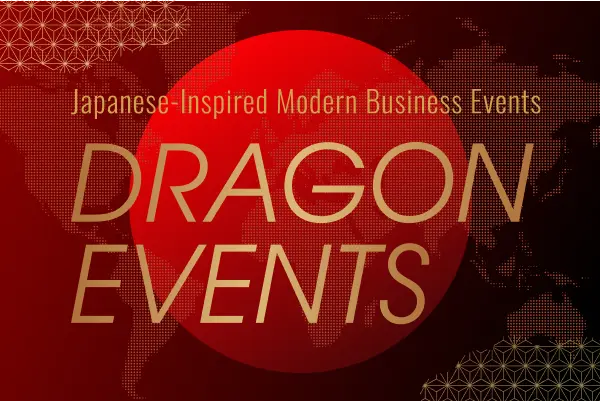What Changes and What Remains
Hello, this is Okutani from GP.
Today, I’d like to talk about the “things that have changed” and the “things that have not” during my 40+ years in the event industry.
I’ll also be sharing some nostalgic photos of old equipment, so whether you’re new to the industry or a veteran, I hope you’ll enjoy a glimpse of how things used to be.
The Changing: No.1 – Audio Equipment

Speakers: the “50” and “60” era
Back in the day, we used to stack large wooden speaker boxes known as “50” and “60.”
The speakers themselves were made of wood, so they weren’t too heavy, but on top of them, we often placed iron-made “horns”—high-frequency speakers.
At concerts for foreign artists and rock bands, these 50s and 60s were stacked to the ceiling like pyramids.
I still remember visiting a warehouse after hearing that Yumi Matsutoya’s concert tour was using the latest speaker system from Meyer, which would later become the foundation of modern speakers.
Wireless microphones have also evolved dramatically.
There was a time when we secretly imported high-quality, high-output mics like Nady and Vega from overseas, even though they were technically illegal in Japan back then.
Nowadays, thanks to digital mixers and digital multi-cables, equipment has become much more compact, and the workload for staff has been greatly reduced.
The Changing: No.2 – Visual Equipment

This is another area that has evolved tremendously.
In the past, there was something called a CRT projector, which used cathode-ray tubes—but it was too expensive and impractical for concerts or live events.
Instead, we used massive projection units like the Eidophor or the light-valve-based Talaria at venues like the Nippon Budokan.
These were literally the size of industrial refrigerators.
Later, companies like SONY and Panasonic developed projectors closer to what we use today, but I was blown away when I first saw the ILA projector from JVC (Victor)—its image quality was revolutionary.
Since then, we’ve moved from tape-based media to fully digital systems, and the pace of innovation has been astonishing.
The Changing: No.3 – Lighting Equipment
In the 1970s, when Queen performed in Japan, follow spotlights were mounted directly on the lighting trusses and operated manually by technicians.
Years later, during David Bowie’s Japan tour, I saw the first computer-controlled moving lights—the original Vari-Lite—and joked that “there must be a monkey inside moving it around!” It was that groundbreaking.
During the setup for Michael Jackson’s first Japan tour, I was shocked to see a follow spot system where operators could move beneath the truss on a track, almost like a monorail.
Today, the lighting world has evolved even further: LED light sources, digital control consoles, and DC motor-based kinetic lights now allow for precise and dynamic control.
The Changing: No.4 – Stage Drawings and Renderings
It’s not just the on-site equipment that has changed—production tools like stage drawings and perspective renderings have also evolved dramatically with technology.
Before computers became mainstream, we used to draw stage plans by hand on tracing paper at a 1:100 scale, revise them manually, and even create miniature 1:100 scale models of stage sets.
Below is a photo of one such stage model I worked on for an artist at the time.
It was featured in a special magazine article on stage production.
(Stage model photo – publication-approved)

Today, this entire process has transformed.
We now use CAD and 3D software, allowing not only precise design but also lighting and video simulations—all on a single computer.
The Unchanging
While many things have evolved, there are, of course, things that have remained the same.
One clear example is in construction work, such as stage structures and decorative materials.
Nails have simply become screws, and hammers have been replaced by electric drivers—but beyond that, not much has changed.
And above all, the most unchanging element is, without question, the performers themselves—the human being.
Human expression, the voice as an instrument, has remained timeless.
Acoustic instruments—guitar, piano, percussion, drums—are just as they were decades ago.
Bonus
In today’s world, where the internet gives us instant access to countless artists and stage designs, I’d like to share three of my personal favorites:
Teenage Violin Prodigy – Himari Yoshimura
I’m not necessarily a classical music fan, but her violin performances are truly captivating.
Formation Dance – Fabulous Sisters
Japanese Jugglers – Kikyo Brothers
I saw their street performance last year, and it blew me away.
Producer, Technical Chief




